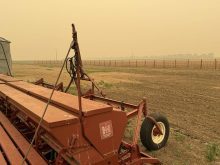A project aimed at enlisting aboriginal kids into 4-H is under way, aimed at starting culturally diverse clubs nation-wide.
Paul Leudtke created the first aboriginal 4-H club in Saskatchewan last year, the only such club on the Prairies. He started with 10 aboriginal youths and expects that number to grow.
“The kids that were in it last year are kind of networking with other kids and getting other kids interested,” Leudtke said. “So I have an overwhelming response of kids wanting to be in the club (this year).”
Read Also

Saskatchewan puts crown land auction on hold
Auctions of Saskatchewan crown lease land are once again on hold.
The Canadian 4-H Council started a pilot project in 2004 to attract aboriginal youths. Six provincial 4-H councils received portions of a $241,500 grant from Agriculture Canada. Since then, 4-H enthusiasts like Leudtke have been developing strategies to recruit native kids.
Leudtke moved to Prince Albert five years ago and started ranching. He soon recruited two native boys to help with farm chores.
He also works at the Prince Albert Ranch Ehrlo Society, a residential treatment facility for troubled youth. He used his position to generate interest in a new 4-H program. In its first year, eight aboriginal youths from the group home and two from surrounding reserves took part.
Leudtke thinks the experiment was successful.
“Kids working with animals is fantastic, teaching empathy, caring for someone other than themselves, and then feeling like you’re part of a community,” he said. “That’s the part I didn’t anticipate.”
Saskatchewan has made good progress compared to other 4-H groups in the country. AnnMarie Nielsen Griffin, of the Saskatchewan 4-H Council, attributed that partly to the growing number of aboriginal youths in the province.
Alberta 4-H representative Marguerite Stark said the province is taking a low-key approach.
“We did not set lofty goals. We really just want to get the interest piqued.”
Stark said organizers are still meeting with Indian and Métis groups in the province. She expects to see the results of her recruiting by December, when registration is over.
Clubs in both Alberta and Saskatchewan will integrate white and native kids into one group, rather than split the cultures apart.
“Rather than be exclusive we’d rather be inclusive,” said Stark.
Saskatchewan has already created supplementary material that includes new cultural content. Stark said Alberta will hold off until there is a demand. Manitoba 4-H will create special programs similar to Saskatchewan. But Don Clark, who was recently named the aboriginal project co-ordinator, said the group is not in a rush.
“We don’t want to set something up that is going to be here for a year and then gone, you know, the following year.”
There are more than 33,000 4-H members nation-wide, aged nine to 21, and 10,500 volunteer leaders organizing 2,500 clubs.
“We would just like to have more kids exposed to 4-H because we know the value of the program,” said Nielsen Griffin.
Ontario, Nova Scotia, Newfoundland and Labrador 4-H clubs are also part of the pilot program.














